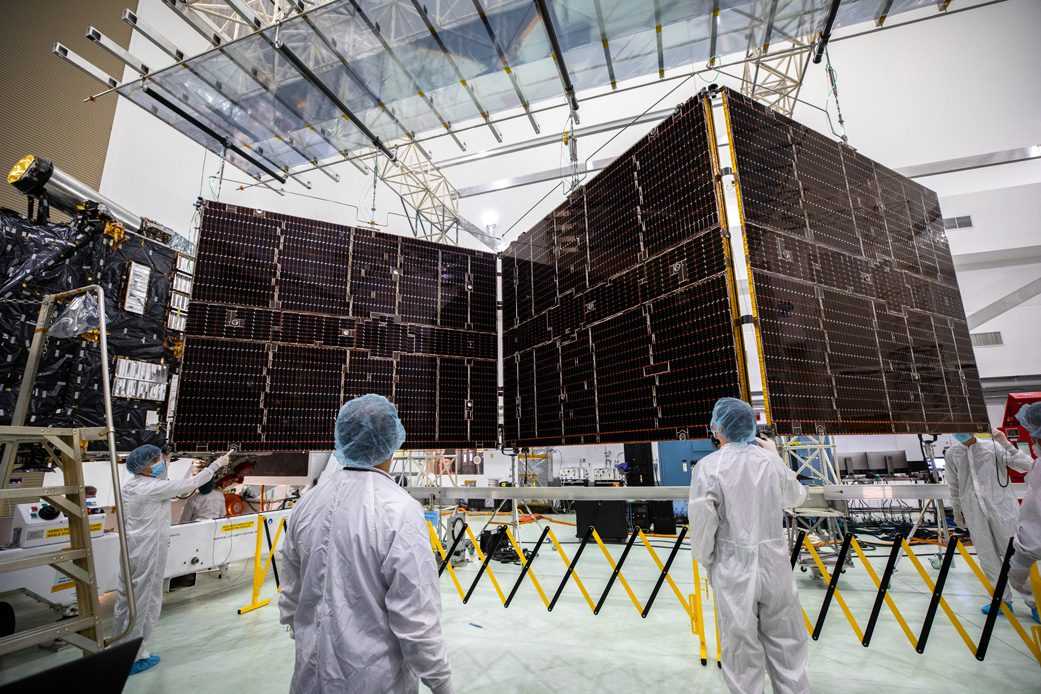Η ώρα ήρθε να πάρει τα ηλιακά του πάνελ. Τα solar arrays της αποστολής NASA Psyche πέρασαν από ένα τελευταίο τεστ ανάπτυξης πριν να εγκατασταθούν μόνιμα πάνω στο διαστημικό σκάφος. Η δοκιμή έγινε στο Astrotech Space Operations κοντά στο Kennedy Space Center της Florida στις ΗΠΑ.
Το Psyche ετοιμάζεται για ένα ταξίδι 2.5 δισεκατομμυρίων μιλίων με ηλιακή ισχύ.
Το ταξίδι θα γίνει προς τον διάσημο ως metal-rich αστεροειδή με το ίδιο όνομα.
Σε ένα clean room στην Astrotech τα πάνελ κούμπωσαν πάνω στο σκάφος και αναπτύχθηκαν πριν να διπλώσουν πάλι. Σε ένα timelapse βίντεο που τραβήχτηκε τον Ιούλιο του 2023 βλέπουμε την κίνηση.
Τα solar arrays θα δώσουν ισχύ για το ταξίδι προς τον αστεροειδή και θα δίνουν ρεύμα στα όργανα. Κάθε array έχει μήκος 37 πόδια (11.3 μέτρα).
Το Psyche αναμένεται να εκτοξευτεί το νωρίτερο στις 5 Οκτωβρίου 2023.
This final installation of the solar arrays took place at Astrotech Space Operations, near Kennedy. The arrays were deployed during testing last year at NASA’s Jet Propulsion Laboratory in Southern California. At 800 square feet (75 square meters), the five-panel, cross-shaped solar arrays are the largest ever deployed at JPL. With the arrays unfurled in flight, the spacecraft will be about the size of a singles tennis court.
Although they will produce more than 20 kilowatts of power when the spacecraft is near Earth, the solar arrays are primarily designed to work in the low light of deep space. The asteroid Psyche is so far from the Sun that even these massive arrays will generate just over 2 kilowatts of power at that distance.
That’s only a little more power than a hair dryer uses but is ample energy to meet Psyche’s electrical needs, including running science instruments, telecommunications, equipment that controls the orbiter’s temperature, and the spacecraft’s superefficient solar electric propulsion engines. The system’s thrusters use electromagnetic fields to accelerate and push out charged atoms, or ions, of the neutral gas xenon. The expelled ions create the thrust that pushes Psyche through space and emit a blue glow.
This thrust is so gentle, it exerts about the same amount of pressure you’d feel holding the weight of one AA battery in your hand. But it’s enough to accelerate Psyche through deep space. With no atmospheric drag to hold it back, the spacecraft will accelerate to speeds of up to 124,000 mph (200,000 kph) relative to Earth during its interplanetary journey to the asteroid belt.
In mid-August, a crew is scheduled to begin loading all 2,392 pounds (1,085 kilograms) of xenon onto the spacecraft over the course of a couple weeks.
A SpaceX Falcon Heavy is targeted to launch Psyche from Launch Complex 39A at Kennedy Space Center no earlier than 10:38 a.m. EDT (7:38 a.m. PDT) on Oct. 5, with additional opportunities scheduled through Oct. 25.
Arizona State University leads the Psyche mission. A division of Caltech in Pasadena, JPL is responsible for the mission’s overall management, system engineering, integration and test, and mission operations. Maxar Technologies in Palo Alto, California, provided the high-power solar electric propulsion spacecraft chassis.
JPL also is providing a technology demonstration instrument called Deep Space Optical Communications that will fly on Psyche in order to test high-data-rate laser communications that could be used by future NASA missions.
Psyche is the 14th mission selected as part of NASA’s Discovery Program, managed by the agency’s Marshall Space Flight Center in Huntsville, Alabama. NASA’s Launch Services Program, based at the Kennedy Space Center, is managing the launch service.


